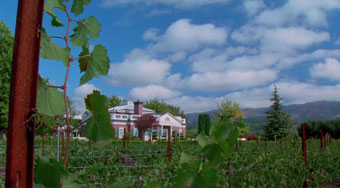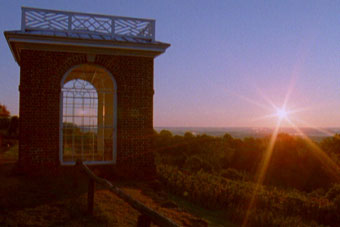Jefferson’s dream of producing first class wine from native American grapes never materialized. Today, only a handful of wines are produced from native grapes in America. The very vines Jefferson maintained so much hope for in America almost completely destroyed the European wine industry in the second half of the nineteenth century.
 Vintners attempting to grow American vines in Europe introduced a North American root louse named Phylloxera vastatrix and it devastated the vineyards of France and Italy. Fortunately, it was discovered that if European vines were grafted onto American rootstocks, they became resistant to the louse. The current grapevines in Europe and America follow the same pattern and the only remaining “true” European vines are now found in Chile.
Vintners attempting to grow American vines in Europe introduced a North American root louse named Phylloxera vastatrix and it devastated the vineyards of France and Italy. Fortunately, it was discovered that if European vines were grafted onto American rootstocks, they became resistant to the louse. The current grapevines in Europe and America follow the same pattern and the only remaining “true” European vines are now found in Chile.
Jefferson’s dream of quality American wine did come true. American, and California wines in particular, have made tremendous strides since Jefferson’s and Adlum’s early attempts. After striving for respect for two hundred years, a famous taste testing in Paris in 1976 proved to the world that American wine had arrived. In the Paris tasting, two California wines, a 1973 Stag’s Leap Cabernet Sauvignon and a 1973 Chateau Montelena Chardonnay scored highest when matched against French Bordeaux and White Burgundies. In fact, American wines made a good showing throughout the entire competition. The Paris tasting gave international recognition and much-needed momentum to American vintners, American wines, and American methods of grape growing and wine production.
Over the past twenty years, wine making in America has burgeoned. From the Napa Valley to the Shenandoah Valley, American wine continues to grow in quality and popularity. Wine is now even being grown at Monticello, renewing Jefferson’s labor of love.

The Monticello vineyard has been re-cultivated to the specifications recorded in Jefferson’s garden book dated 1807. Just as archaeologists probed the vineyard site for evidence of earlier terracing and posts, so too was it necessary to uncover the character of the grape varieties. Most Vinifera cultivars are of ancient origin and have retained stability in their characteristics. The problem lies in the nomenclature. Scholars struggled to find modern synonyms for what Jefferson called the “Queen’s grape” (Regina) or the “Great July” (Luglienga), or what was sold to Jefferson as the “Black cluster” (Cabernet Sauvignon) or “brickcoloured type” (Chasselas Rose). The Monticello vineyard is currently planted with 22 different varieties from Europe and America, and wine is being produced from its vines.
An uneasy relationship exists between horticulture and history on the Southeast slopes of Monticello. Jefferson’s vineyard plantings mostly failed. However, modern techniques that employ the use of native rootstock, sophisticated grafting techniques, and modern pesticides allow Monticello to recreate the original effort.
While many aspects of Jefferson’s vision for a gentile agrarian society have been relegated to the pages of history books, one small dream is being fulfilled: the American vineyard. Our country has sacrificed the gentler life in favor of silicon-based efficiency yet technology cannot speed up a harvest, or determine the perfect blend of flavors in a new vintage.
Mr. Jefferson would be pleased to see that his vision of an agrarian society is alive and flourishing in the vineyards of his native Virginia countryside he loved so dearly It is a society steeped in the enjoyment of good food, good company; and the fertile texture of an historic landscape. Jefferson’s dream of elevating wine to the status of America’s “national drink” may yet become one of his great legacies.
